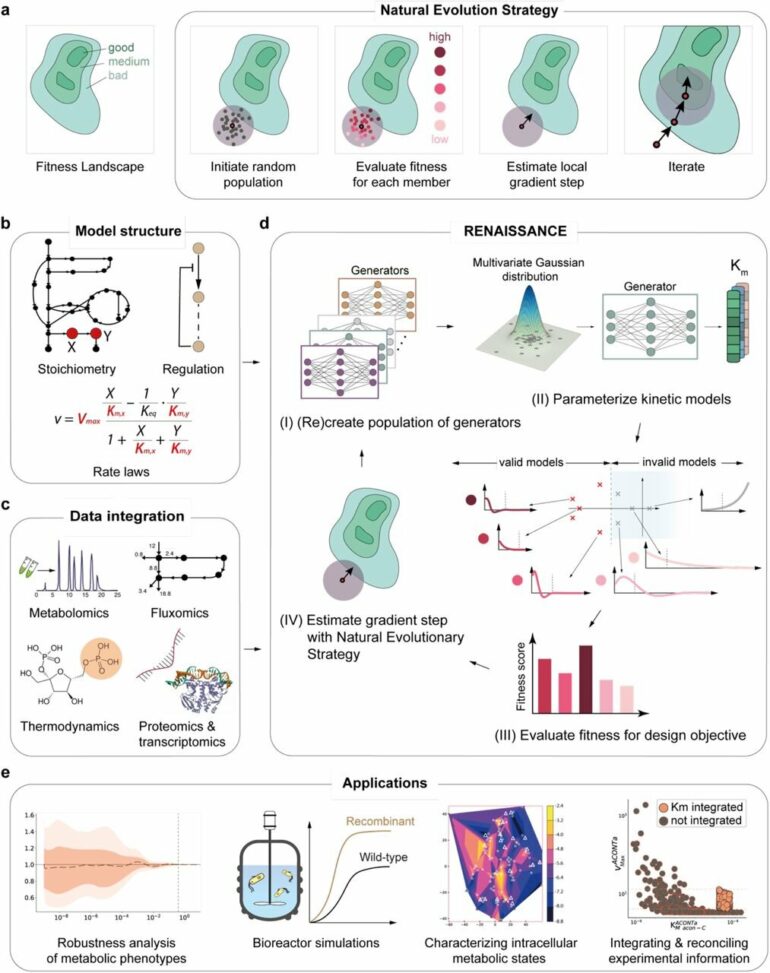Understanding how cells process nutrients and produce energy—collectively known as metabolism—is essential in biology. Modern biology generates large datasets on various cellular activities, but integrating and analyzing the vast amounts of data on cellular processes to determine metabolic states is a complex task.
Kinetic models offer a way to decode this complexity by providing mathematical representations of cellular metabolism. They act as detailed maps that describe how molecules interact and transform within a cell, depicting how substances are converted into energy and other products over time. This helps scientists understand the biochemical processes underpinning cellular metabolism. Despite their potential, developing kinetic models is challenging due to the difficulty in determining the parameters that control cellular processes.
A team of researchers led by Ljubisa Miskovic and Vassily Hatzimanikatis at EPFL has now created RENAISSANCE, an AI-based tool that simplifies the creation of kinetic models. RENAISSANCE combines various types of cellular data to accurately depict metabolic states, making it easier to understand how cells function. RENAISSANCE stands out as a major advancement in computational biology, opening new avenues for research and innovation in health and biotechnology.
In their study published in Nature Catalysis, the researchers used RENAISSANCE to create kinetic models that accurately reflected Escherichia coli’s metabolic behavior. The tool successfully generated models that matched experimentally observed metabolic behaviors, simulating how the bacteria would adjust their metabolism over time in a bioreactor.
The kinetics models also proved to be robust, maintaining stability even when subjected to genetic and environmental condition perturbations. This indicates that the models can reliably predict the cellular response to different scenarios, enhancing their practical utility in research and industrial applications.
“Despite advancements in omics techniques, inadequate data coverage remains a persistent challenge,” says Miskovic. “For instance, metabolomics and proteomics can detect and quantify only a limited number of metabolites and proteins. Modeling techniques that integrate and reconcile omics data from various sources can compensate for this limitation and enhance systems understanding.
“By combining omics data and other relevant information, such as extracellular medium content, physicochemical data, and expert knowledge, RENAISSANCE allows us to accurately quantify unknown intracellular metabolic states, including metabolic fluxes and metabolite concentrations.”
RENAISSANCE’s ability to accurately model cellular metabolism has significant implications, offering a powerful tool for studying metabolic changes whether they are induced by disease or not, and aiding in the development of new treatments and biotechnologies. Its ease of use and efficiency will enable a broader range of researchers in academia and industry to utilize kinetic models effectively and will foster collaboration.
More information:
Subham Choudhury et al, Generative machine learning produces kinetic models that accurately characterize intracellular metabolic states, Nature Catalysis (2024). DOI: 10.1038/s41929-024-01220-6
Provided by
Ecole Polytechnique Federale de Lausanne
Citation:
AI tool maps out cell metabolism with precision (2024, August 30)



